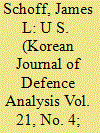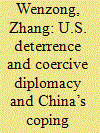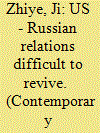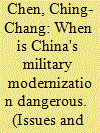| Srl | Item |
| 1 |
ID:
095927


|
|
|
|
|
| Publication |
2010.
|
| Summary/Abstract |
A newly emerging area in international economics looks at the cross-correlation coefficient between past and future values of the trade balance and movement in the current exchange rate as a way of analyzing the response of the trade balance to exchange rate changes. Since the cross-correlation function follows a symmetric pattern, it comes under the heading of the S-Curve. Previous studies have considered the experience of developed and developing countries with the S-Curve, excluding China. In this paper we consider the Chinese experience. We show that when aggregate trade data between China and the U.S. are considered, there is no evidence of the S-Curve. However, when the data are disaggregated by commodity, the S-Curve is supported in almost 50% of the close to 100 industries considered. Furthermore, it appears that commodity types do not have any influence in determining the existence of an S-Curve pattern.
|
|
|
|
|
|
|
|
|
|
|
|
|
|
|
|
| 2 |
ID:
132744


|
|
|
|
|
| Publication |
2014.
|
| Summary/Abstract |
Enhanced Geothermal Systems (EGS) could supply a significant fraction of the low-temperature (<125 °C) thermal energy used in the United States through Geothermal District Heating (GDH). In this study we develop a regional model to evaluate the potential for EGS district heating in the states of New York and Pennsylvania by simulating an EGS district heating network at each population center within the study region and estimating the levelized cost of heat (LCOH) from GDH for each community. LCOHs were then compiled into a supply curve from which several conclusions could be drawn.
Our evaluation revealed that EGS district heating has the potential to supply cost-effective energy for space and water heating in several New York and Pennsylvania communities in the near future. To realize wider deployment, modest improvements in EGS technology, escalation of natural gas prices, and/or government incentives will likely be required to enable GDH to compete with other heating alternatives today. EGS reservoir flow rates, drilling costs, system lifetimes, and fluid return temperatures have significant effects on the LCOH of GDH and thus will provide the highest return on R&D investment, while creative implementation strategies can help EGS district heating overcome initial cost barriers that exist today.
|
|
|
|
|
|
|
|
|
|
|
|
|
|
|
|
| 3 |
ID:
093906


|
|
|
| 4 |
ID:
152182


|
|
|
|
|
| Summary/Abstract |
Deterrence and coercion are two kinds of strategies, the latter being more aggressive than the former. The U.S. Asia-Pacific Rebalancing strategy is an important diplomatic legacy of Obama’s administration. For the issues involving the Diaoyu Islands, the South China Sea, cyber security, DPRK’s nuclear program, and Iran’s nuclear program, the U.S. has carried out military deterrence and non-force coercion against China. But generally, these are low-level coercive measures and distinct from the severe economic sanction and diplomatic isolation imposed by the U.S. on Russia, Syria, DPRK and Iran in recent years. Concerning issues where the U.S. and China hold distinct views,there would be less strategic leeway for the two countries. If the U.S. is to strengthen deterrence and coercion towards China, China can respond more actively and effectively, but it will be more difficult to build a new model of China-U.S. major-country relationship.
|
|
|
|
|
|
|
|
|
|
|
|
|
|
|
|
| 5 |
ID:
092707


|
|
|
| 6 |
ID:
094386


|
|
|
| 7 |
ID:
094160


|
|
|